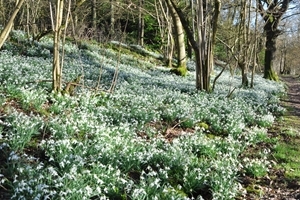Snowdrop
 I don’t know about you, but there is something very joyful about spotting the first little clump of flowering snowdrops. There are about 20 species of snowdrop to be found in the UK, but the most common one we see growing is the variety Galanthus nivalis. The name Galanthus is from the Greek, meaning ‘milk flower’, and the species name nivalis means ‘of the snow’.
I don’t know about you, but there is something very joyful about spotting the first little clump of flowering snowdrops. There are about 20 species of snowdrop to be found in the UK, but the most common one we see growing is the variety Galanthus nivalis. The name Galanthus is from the Greek, meaning ‘milk flower’, and the species name nivalis means ‘of the snow’.
Although snowdrops are widely spread and commonly found, it might surprise you that they are not believed to be native to this country. They were actually brought here in the 15th century by Italian monks, who introduced the bulbs into the gardens of monasteries. From here they were soon spotted and enjoyed by visitors, who collected a few bulbs to plant around their own homes.
Snowdrops are naturally distributed from southern-central Europe, through the eastern Mediterranean, down to the mountains of the Middle East, but with the highest concentration of species and diversity in Turkey and the Caucasus.
Snowdrops mainly spread by bulb division and do not depend on pollinators, as they often flower so early in the year that there are not many insects around. However, if some warm spring days do occur, then pollinators will visit the flowers for nectar and pollen, especially if they are located in a sunny place, where flowers tend to produce more nectar and pollen than if planted in the shade. I have watched early emerging queen bumblebees seeking out snowdrop flowers for a first meal of the year!
Snowdrop lectin (lectins are a type of protein that can bind to cell membranes) is an effective insecticide, and can be used against a range of pests. Research is beginning to suggest that snowdrop lectin could also be a candidate for introduction into genetically engineered crops, such as tobacco and tomatoes, to increase their resistance to insect pests. Another use of snowdrop lectin that is also being studied is its potential activity against HIV.
The snowdrop also contains an alkaloid, galanthamine, which has been approved for use in the management of Alzheimer’s disease in a number of countries. Galanthamine is also used in the treatment of traumatic injuries to the nervous system.
So it is not only a tough little flower, which braves hard frosts and snowfall to bring a smile to our faces at this rather drab time of year, but it is also a plant that could potentially bring many other hidden benefits too!
Peter Thompson
Advisory
Read more from Peter Thompson at his blog.

Download Peter Thompson's essential 26-page book, featuring beautiful photography and detailed profiles of Britain's wildlife
Download FREE >